Abstract
This is a unique case which enables us to broaden our scope for treating emergencies related to very vital organs like the eye. It teaches us the importance of understanding disease and the application of homoeopathy. It also demonstrates the concept of pathology, pathogenesis and tissue affection, which enables us to understand the disease picture and prescribe according to Boger’s method of prescribing. Utilization of modern diagnostic techniques like slit lamp examination in this particular case, helps ascertain the stage of the disease.
CASE:
A 45 year old fisherman reported with a history of injury to the left eye from an iron wire, which occurred while fishing 15 days ago. Thereafter he developed left eye redness, lacrimation, swelling, pain and visual loss. Difficulty in opening the eye especially in light. Pain in the left eye, stitching pain 3+ < light 3+, < cold air2+ and > wamth3+.
The patient had visited an ophthalmologist and received the following treatment (Tab Odoxil, Tab Wysolone, Zoxan Eye Ointment, E/D Mil flox, E/D Predmet for 15 days). He was not responding to the treatment ; he developed Hypopyon (pus in the anterior chamber) which is evident in the photograph.
Note. These are the actual photographs of the patient published with patient’s consent.
O/E : Left Eye (Left eye Photographs – Naked eye appearance and Slit lamp photography) Torch Light Examination: Both lids oedema. Circumcorneal congestion. Photophobia (Homeopathy Treatment for Photophobia). Corneal wound. Hypopion

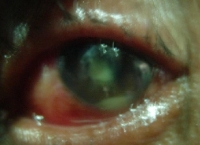
Slit Lamp Examination: Circumcorneal Congestion. Photophobia. Corneal Laceration at 8 o’clock position. Hypopion (PUS in the anterior chamber) Pupil not reacting to light. (Pupil Fixed) Complicated Cataract.
CLINICAL UNDERSTANDING
Post traumatic suppuration and inflammation like iritis and cataract.
HOMOEOPATHIC UNDERSTANDING
Acute non miasmatic disease with secondary miasmatic expression (Tuberculo-syphilitic)
TREATMENT STRATEGY:
It’s important to understand the disease phenomenon, the stage of disease and define the role of homoeopathy in curing this patient.
STEP 1 Medical Treatment (Acute Remedy → Constitutional Treatment)
Corneal injury with infection → pus in the anterior chamber; iritis → Complicated cataract. The aim is to treat the infection – pus in the anterior chamber should disappear. To reduce the inflammatory signs – (control iritis)
completely quiet the eye – treat infection as well as inflammation.
CAUTION: Progressive hypopion may block the angle of the anterior chamber leading to secondary glaucoma. It is very important to treat the infection rapidly and remove the pus.
STEP 2 Surgical Treatment
Cataract is a sequeale to the inflammation in the eye. It is a hindrance to normal vision. It requires surgical treatment (cataract extraction with iridectomy in order to release the posterior synechae) to restore normal vision. Cataract / Posterior synechae (adhesions) are the sequelae of infection and inflammation which needs surgical treatment. Removal of hard cataract will help to restore the vision at the earliest. Surgical intervention could not be done earlier due to presence of active infection and pus in the eye which can induce Pan Opthalmitis.
Application of The Strategy
Step 1 Medical Treatment
Boger’s Approach (Order of totality construction):
Modalities (Causation, Aggravating and Ameliorating) Sensations and tissue affinity
Totality
1. A/F Injury to Eye
2. Eye Pain < Cold Air
3. Eye Pain > Warmth
4. Pain Stitching.
5. Suppurative Wound
6. Hypopyon (Pus in the anterior chamber)
Repertorisation:
Differential Remedies:
Hepar Sulph, Silicea, Spigelia, Sulphur, Aconite
Hepar Sulph and Silicea are both remedies well known for ailments from injuries. Injuries may undergo a process of suppuration, ie pus formation.
The process is different in both the remedies.
Hepar sulph: Every injury suppurates and there is threatening pus formation.
Quick suppurations. Violence.
Silicea: It has suppurations which are very slow and there would be impending or incomplete abscesses. Only after a dose or two of Silicea will the process be hastened. There may be symptoms of abscess, but it takes long to ripen; it will be indurated.
Cornea is the seat of disease in both the remedies but the difference lies in the pathology – Hepar is known for ulcerations and Silicea for cicatrices / opacification. Both have common modalities like cold aggravation and warm amelioration. The difference lies in the degree of expression. Hepar sulph is known for its violence, rapidity and deeper action. It is highly sensitive in both nature and disease expression. Silicea is known for its torpidity, slowness, delayed, stubborn and incomplete processes at the general expression as well as the suppurative process.
Spigelia:
Affinity for nerves → neuralgia. It produces inflammatory pathologies rather than suppurative pains. Very acute manifestation. Deep seated Inflammatory pains involving cornea, iris and sclera. Neuralgia of eyes, especially where there is great soreness, and one can scarcely bear a touch; affections of the eyeball; eyelids; optic nerve. Pains in eyes, deeply seated in sockets.
Eyes : sore, drawing ache; sunken; feel large; red; flowing tears on affected side; squinting; yellow rings about.
Sulphur:
Generally has psoric dimension → produces more of pruritic and inflammatory eye conditions involving the exterior portions of the eye, ie. Eye Lid, Eye Lashes, Conjuctiva etc. Eye burns; cutting sensation, as from sand; bursting in balls; quivering. Burning sensation, photophobia, opthalmia.
Miasmatic view:
Hepar Sulph generally originates from tubercular miasm and later progresses into syphilitic dimension.
Silicea originates from sycotic miasm and later may advance into tubercular dimension.
Miasmatic study can be done through the expression of disease while it progresses from its origin until the end.
Final Acute Remedy Selction:Hepar Sulph
Criteria of remedy selection relevant to this case:
1. Causation
2. Miasmatic consideration: Tubercular-Syphilitic disease activity, injury which leads to suppuration with rapidity and resulting in post infective state, post inflammatory complication.
3. Pace of development of pathology: Rapid; Injury suppuration despite receiving antibiotics (oral and topical) .
4. Predominant location of disease – corneal and anterior chamber
Remedy (Acute Remedy) Hepar Sulph
(3-5-2010 till 27-6-2011) HEPAR SULPH 200 M 5 PILLS 4 HOURLY
Follow ups :
Pain/Swelling / Lacrymation / Redness / Pus/ Photophobia — 0 –
Hypopion : Disappeared
|
CONSTITUTIONAL DATA Mental Dispositional qualities Calm Industrious Hardworking Physical generals Chilly patient Winter cracks Suppurating injury |
Impression: Silicea
According to the ORGANON OF MEDICINE, once the acute inflammatory and infective process is controlled, then case should be followed by deep a acting constitutional remedy.
Note: Although the constitutional remedy itself covered the disease acute totality, it was not prescribed, since the constitutional remedy did not correspond with the depth of pathology and qualitative state of susceptibility.
27-6-2011
SILICEA 200 single dose given and patient was normal, thereafter.
Strategy Step 2 (Surgical Line of Treatment For The Cataract):
Patient’s eye was quiet after homoeopathic treatment which eventually made ground for surgical intervention. This case was under continuous supervision of an ophthalmologist. Seeing the response of homoeopathic medicine, the patient was not put on any pre-operative antibiotic regime by the ophthalmologist. Cataract extraction with PCIOL insertion was done.


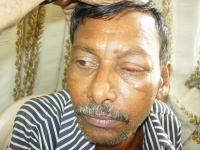
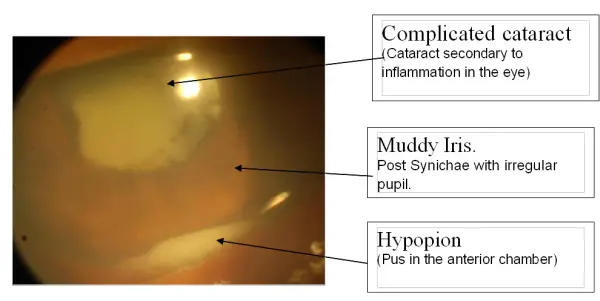
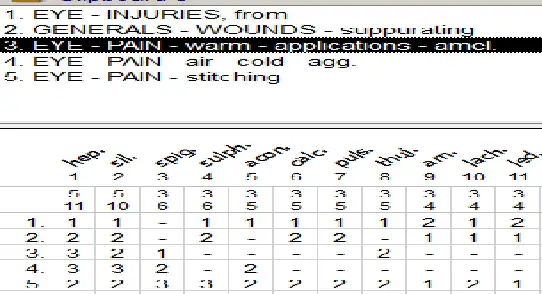
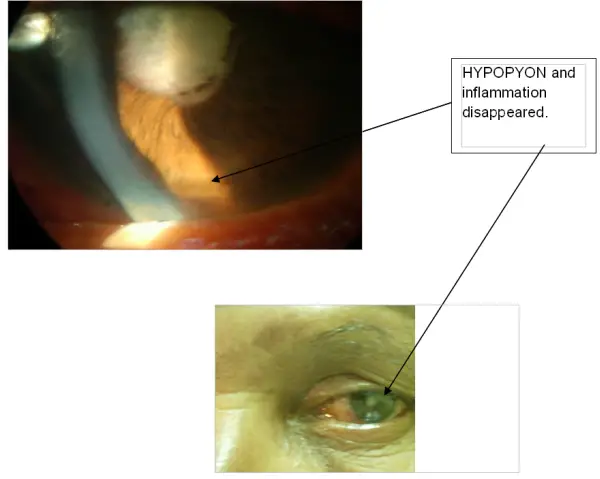
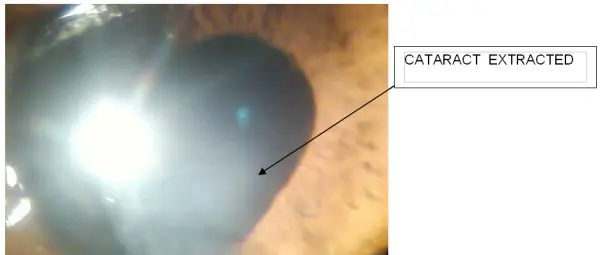





Excellent approach in Ophthalmology. Keep it up Dr. Gupta.
Such a wonderfull and logical explaination of prescription is given..
Well Done Dr. Gupta.
Too good….excellent work…logical and simplified explanation…n most importantly thanks a lot for sharing with us….Keep it Dr.Rakesh Gupta
Thank you for sharing your case with us. Excellent solution for your patient and fantastic explanations for us. Wonderful!
Excellent approach n presentation of case, sir
excellent case presentation sir ,thank u sir keep up the good work. sir can you please give me your mobile and clinic phone number and email ID so that I can contact and send you the cases.
thank u
Dr.Niranjan sahoo
[email protected]
please reply sir
wonderfull and logical explaination of prescription is given
Mere papa ko v asa hi chot lga h Dr. Rakesh gupta doctor ap kidar ilaj karte ho address or contact number nhi pta.
Such a wonderful,logical n simplified explanation sir …thanks a lot for sharing dis case
Nice explanation sir, please keep sharing such cases.
Superbly and concise explanation, about the patient, chief complaint and conclusion on what basis medicine was chose…
Brilliant Sir !!
Really explained amazingly..thankyou sir learned so fine difference and way of prescribing hepar sulph n silica
Excellent explanation on treatment of the eye a homeopathic approach will benefit many patients
Will appreciate his contact details
Thank you sir…Mob no 9987527451..